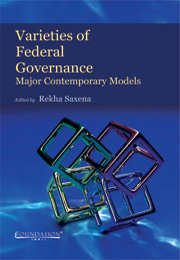Book contents
- Frontmatter
- Contents
- List of Contributors
- Foreword
- Acknowledgements
- Introduction
- I Theoretical and Comparative Dimensions
- II Presidential Federal Systems
- 3 Political Coercion and Administrative Cooperation in U.S. Intergovernmental Relations
- 4 What Makes the Swiss Multicultural Federalism Work
- 5 Local Governments in the Brazilian Federation
- 6 Russian Federalism: Does it Work?
- 7 Federalism in Pakistan
- III Commonwealth Parliamentary Federations
- IV Non-Commonwealth Parliamentary Federations in Afro-Asia
- V European Parliamentary Federations
- VI Devolutionary Systems
- VII Supranational Confederalism/Federalism?
6 - Russian Federalism: Does it Work?
from II - Presidential Federal Systems
Published online by Cambridge University Press: 05 June 2012
- Frontmatter
- Contents
- List of Contributors
- Foreword
- Acknowledgements
- Introduction
- I Theoretical and Comparative Dimensions
- II Presidential Federal Systems
- 3 Political Coercion and Administrative Cooperation in U.S. Intergovernmental Relations
- 4 What Makes the Swiss Multicultural Federalism Work
- 5 Local Governments in the Brazilian Federation
- 6 Russian Federalism: Does it Work?
- 7 Federalism in Pakistan
- III Commonwealth Parliamentary Federations
- IV Non-Commonwealth Parliamentary Federations in Afro-Asia
- V European Parliamentary Federations
- VI Devolutionary Systems
- VII Supranational Confederalism/Federalism?
Summary
Since 1991 the relations along the axis ‘center-regions’ have been one of the main factors determining stability and effective development of Russia. Federalism and regionalism have brought into life new elements and networks, becoming themselves actors in the political game and thus creating system effects. The entire development of Russia starting from 1990 until today has been a complicated, controversial period of the transformation of a unitary state into a federation.
Federalism is mainly a political phenomenon, a form of political conflict between individuals with different interests regarding the principles of government organization and institutional design. In the federal context the process of determining ‘who will get what, when and how’ appears to become a sort of political bargaining on whose version of the federal union is to be actually implemented. As a result the political role of regions depends on the level of their autonomy and their ability for participation in federal decision-making process. In Russia these two crucial things have been in constant process of change.
1990–1992 (until March): the so-called Parade of Sovereignties
During that period the ethnic formations within Russia (former autonomous republics and okrugs) sought to upgrade their political status, to win recognition as independent republics as a part of the Russian Federation (RF). Movements for sovereignty were led by the republics of Tatarstan, Bashkorostan, Yakutia and others. At the same time the national idea, the idea of the restoration of ethnic states, language and culture clearly prevailed.
- Type
- Chapter
- Information
- Varieties of Federal GovernanceMajor Contemporary Models, pp. 86 - 103Publisher: Foundation BooksPrint publication year: 2011
- 1
- Cited by



